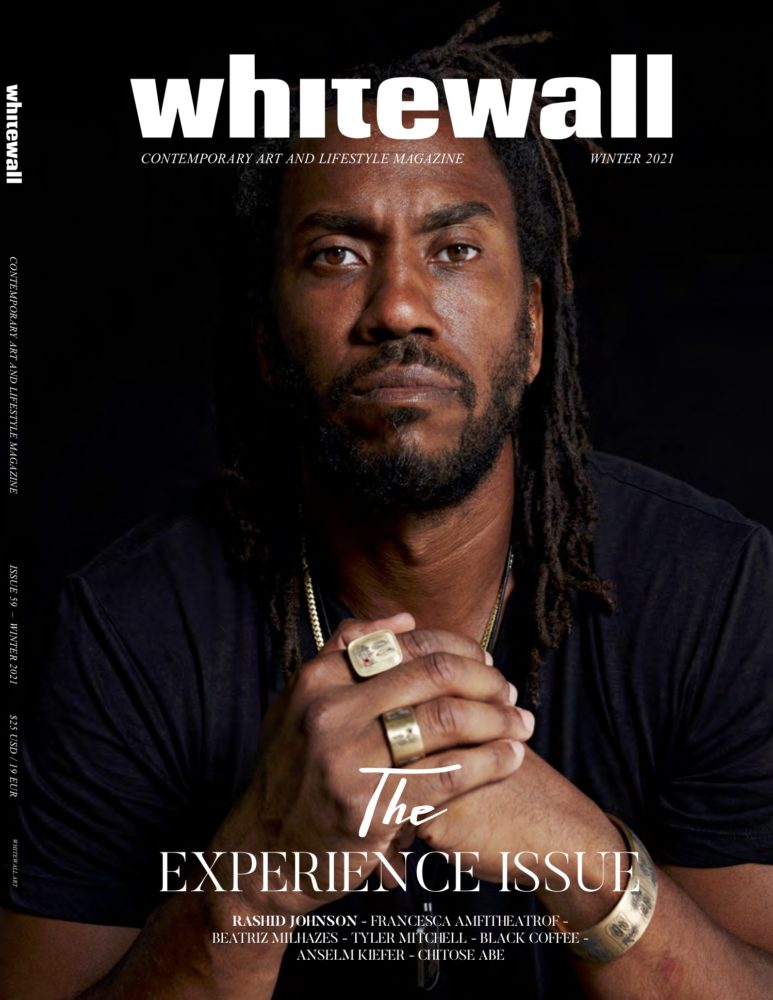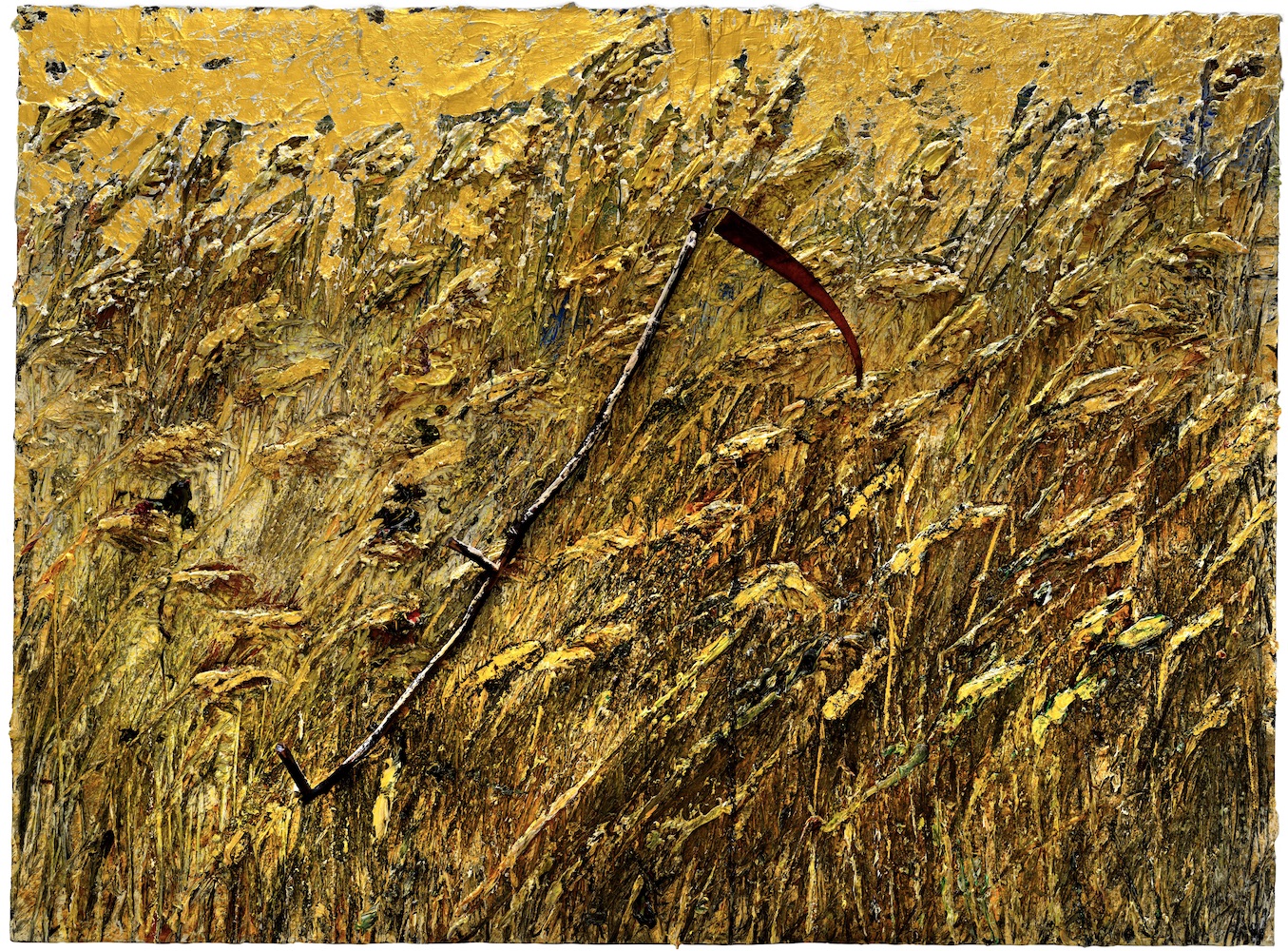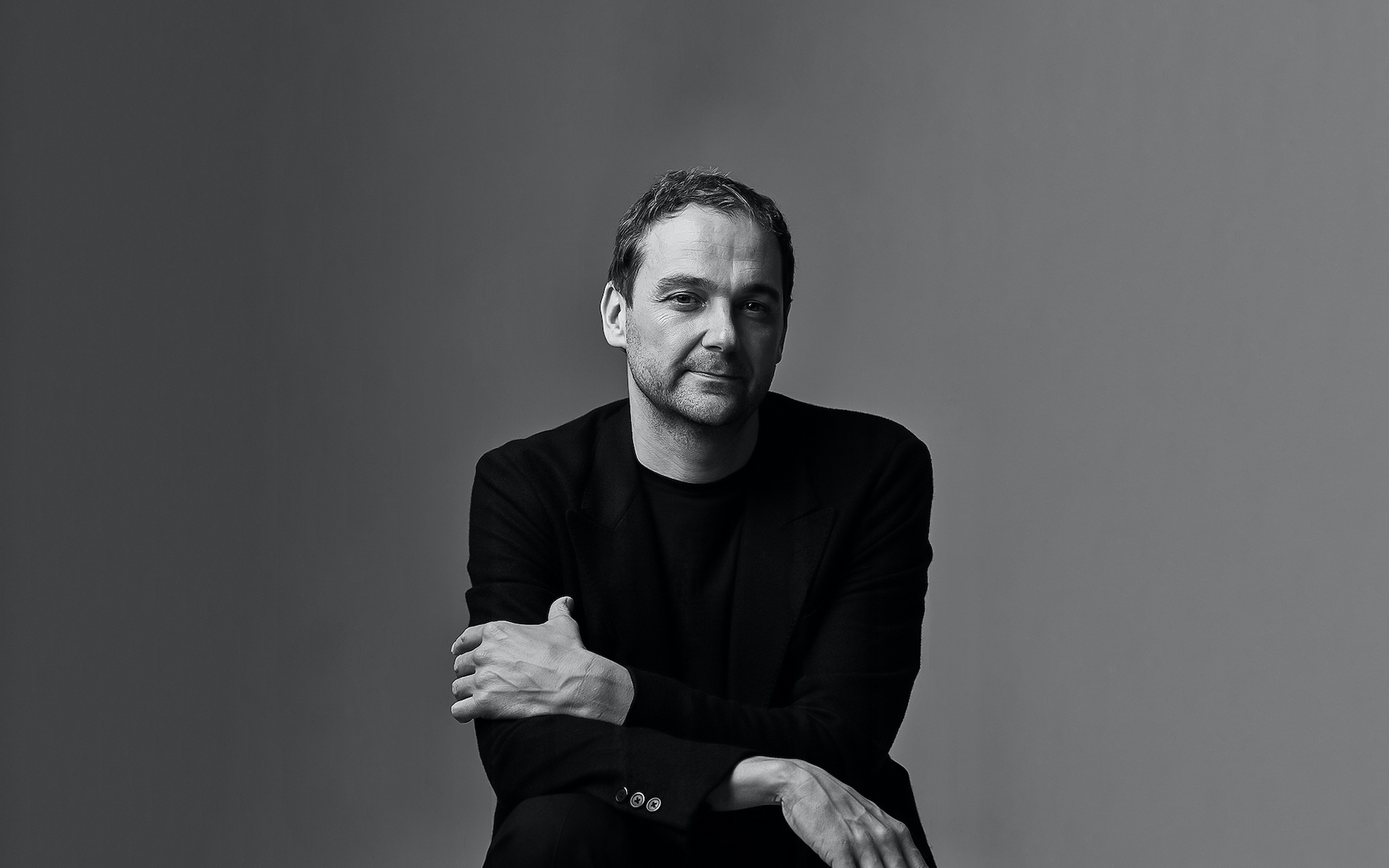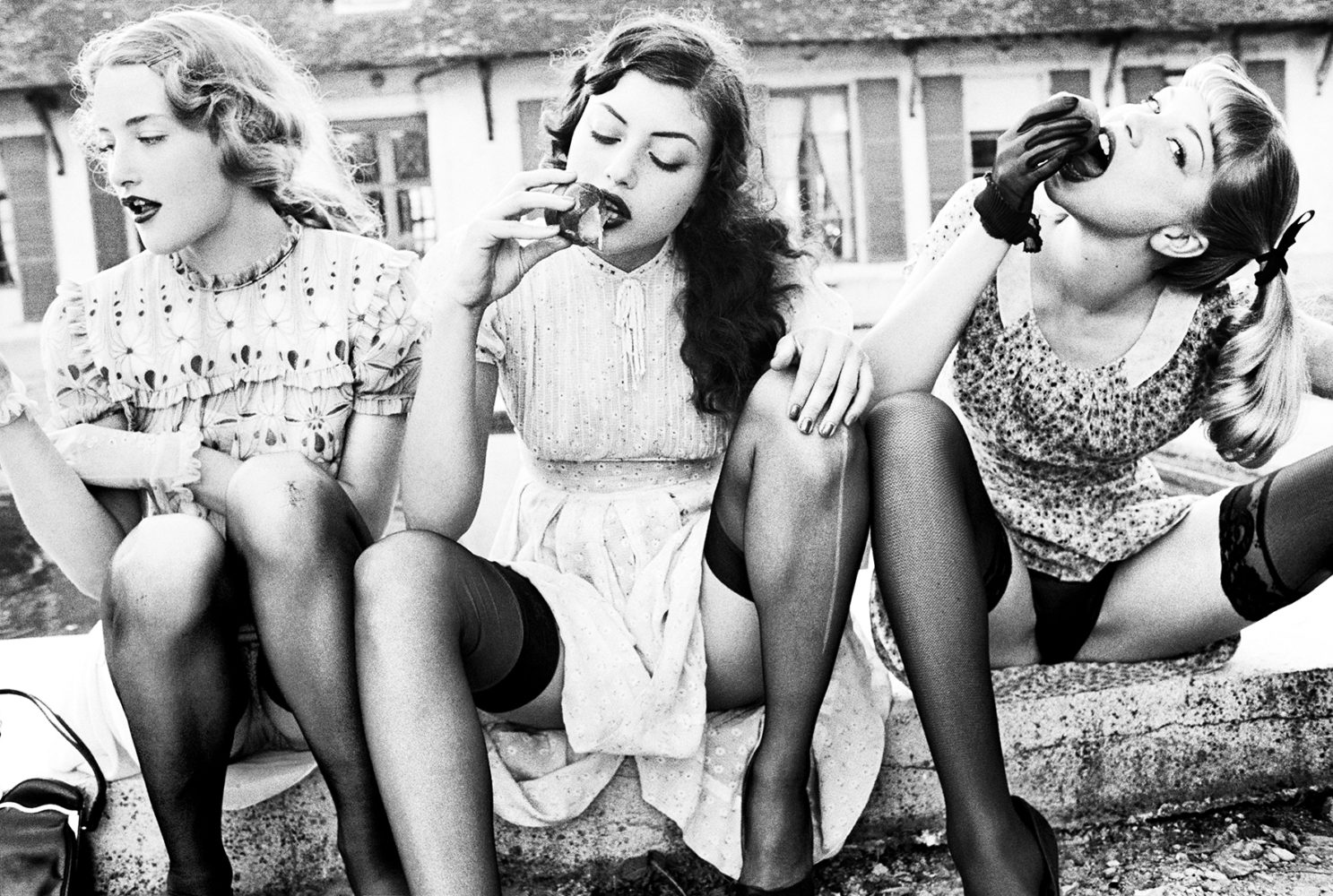Last spring, Rashid Johnson captured the global mood with his “Anxious Red Drawings” series in deep red oil stick on cotton rag paper. He made the works, depicting crude faces with swirling eyes and gnashing mouths, in response to the COVID-19 pandemic, and evoked our collective feeling of anxiety and tension.
The new drawings came from Johnson’s ongoing “Anxious Men” series, first imagined as a self-portrait. Looking to address his own experiences with stress and unease, he found a universal response to and understanding of the works ever since they were first exhibited. At a time when worry abounds, Johnson managed to create an immediately recognizable symbol for anxiety—like the smiley face for happiness.
“Anxious Men” was an obvious choice to explore with Liz Swig of LIZWORKS when she approached the artist in late 2019 to collaborate on a new collection of jewelry. The resulting line of ring bands, signet rings, military tags, and cuffs in gold and titanium feature agitated engravings punctuated by a single red stone. The collaboration debuted last fall, again managing to capture the spirit of 2020. Sales benefit the Black Mental Health Alliance and Prep for Prep.
Johnson—whose recent show “Waves” at Hauser & Wirth in London closed December 23, 2020—spoke with Whitewall from his studio in Long Island, New York, about carrying with you a universal symbol for the human condition.
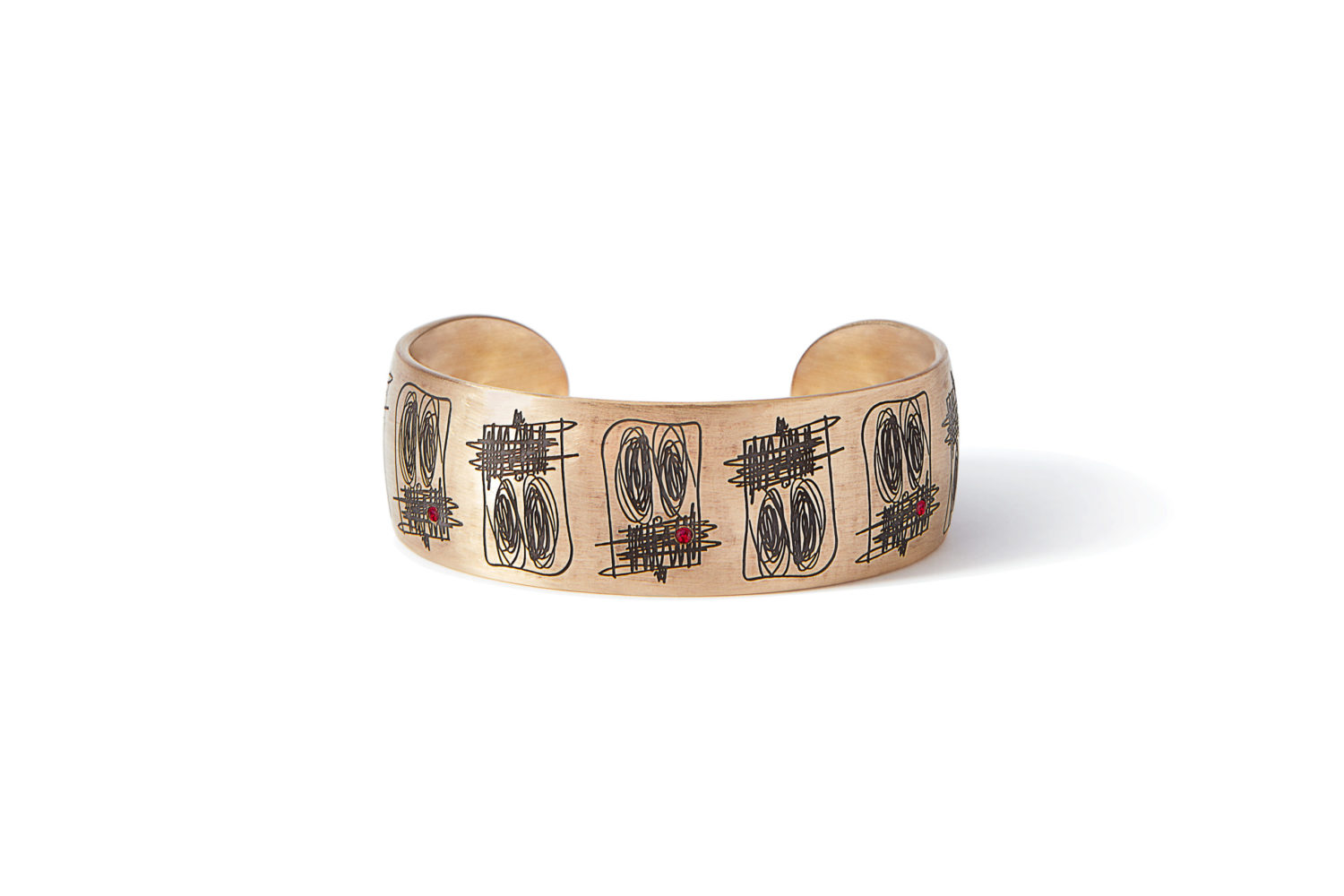
Gold Cuff from Lizworks Anxious Men collection by Rashid Johnson.
WHITEWALL: How did Liz Swig frst approach you for this collaboration?
RASHID JOHNSON: Liz and I have known each other for many years, and she came to me and said, “I’ve been thinking about working with a male artist, exploring a different energy.” I don’t have a lot of history with wearable art and jewelry, but it’s something that is interesting to me. I wear jewelry myself. We started to have a dialogue and we were really on the same page from the beginning, thinking about a body of work that I had produced called “Anxious Men.” From there we started saying, “What does it look like? How do we translate it?” And we experimented, explored, and found ourselves in a good place with the ideas, and next thing you know we were rolling along.
WW: What made the “Anxious Men” series ftting for this?
RJ: For me the “Anxious Men” and some of the things they discuss were really attractive to imagine in a wearable—discussing these ideas of anxiety and frustration and fear. That’s something that you as an individual, if it’s something you’ve struggled with, it’s something you carry with you. It’s mobile. You don’t leave your anxiety at home. It travels with you. I really like the idea that it could translate into something that is nimble, something that moves—that kind of reminder was really intriguing.
WW: It’s interesting to see this almost freehand aggressive engraving on a piece of precious metal. It’s surprising in a jewelry piece.
RJ: Yeah, very much so. There is a crudeness to it. The pieces are quite sculptural, but they really translate, and the questions that they ask and the ideas that belong to them, they just translate. Both Liz and I were really excited to see that the idea worked. This doesn’t betray the ideas and the concerns that the work had in its initial life as paintings. It still carries the same critical concern, and it doesn’t cheapen or devalue the things that were really present and really prescient to what my original intentions were.
WW: I wonder if you see having a representation of anxiety outside of the body, but still on it, as some sort of grounding talisman?
RJ: Absolutely. Oftentimes we think about jewelry in this relationship to memento and memory. And I like that this work can carry those same sentiments potentially, while also carrying a different kind of cathartic weight. This is an opportunity to confront those concerns or be reminded of them and not feel handicapped by them.
One of the organizations that I’m donating the proceeds of the sales to is the Black Mental Health Alliance, which works to destigmatize mental health concerns in communities of color. So the idea that one would prominently wear something that speaks to their anxiety, and wear it in almost a celebratory fashion, is in line with what I’m trying to do on the charitable side of things. Which is to say, look, this is not something you have to be, that you have to see as a blight. That it’s something that you would not necessarily celebrate, but not bury.
I think in communities of color it’s important that we don’t perpetuate this idea that anxiety is emasculating or weak; it’s really a symptom of awareness. It would be odd for people in certain communities to not be anxious, in particular Black and Brown people, in our engagement with the world and our relationships to systems and authority spaces. It would be strange for us to not be anxious. I hope that this speaks to that deconstructing of what I see as the obvious.
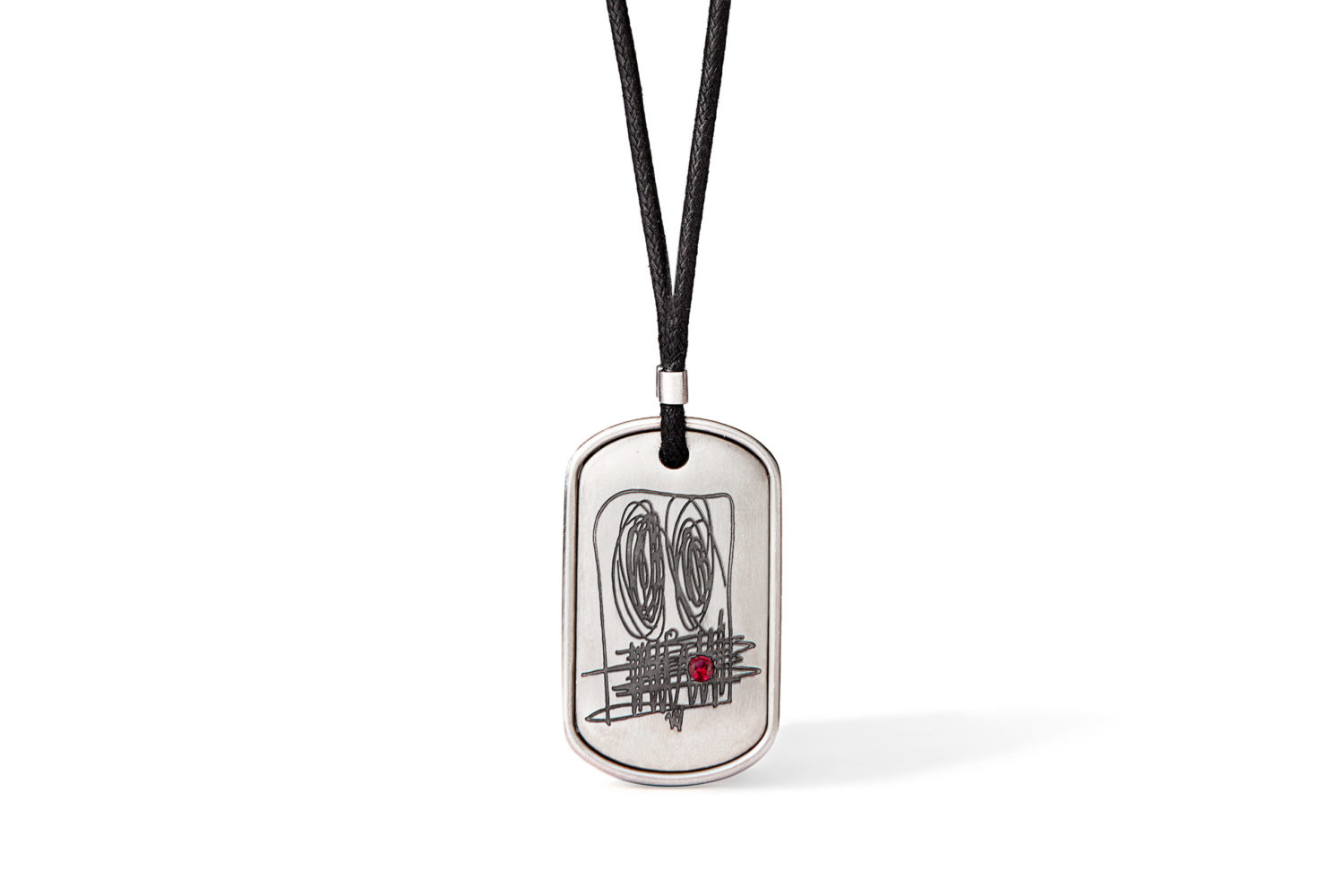
Titanium Military Tag from Lizworks Anxious Men collection by Rashid Johnson.
WW: What was it like for you when you frst made and presented the “Anxious Men” series?
RJ: There was some vulnerability there, for sure. But the job of the artist, if you were to ask the filmmaker Akira Kurosawa, is to not avert their eyes. So in that respect, I felt like it was obligatory for me to discuss something that was really present in my life. Which was anxiety, fear, and frustration. Some of it stemmed from things I was dealing with personally; some of it stemmed from things we were dealing with collectively. The most honest way for me to engage was me being sincere. And when an artist isn’t doing that, then we generally have bigger problems.
WW: We read that at first you saw it as a self-portrait, but then saw it as more of a collective representation. Was there a moment for you when that realization happened?
RJ: Honestly, it came about on exhibition, as soon as I started showing the works and people responded the way they responded. And the realization that I had from that point was, “Oh, wow, more or less I’m not alone.” Other people are seeing themselves.
It’s so interesting with that body of work. There’s no real reason other than psychological that one would see these scrawled, scribbled characters and say, “That’s anxiety,” but no one ever questions it either. Which is really fascinating. I have called them “Anxious Men” and everyone is like, “Yeah, absolutely.”
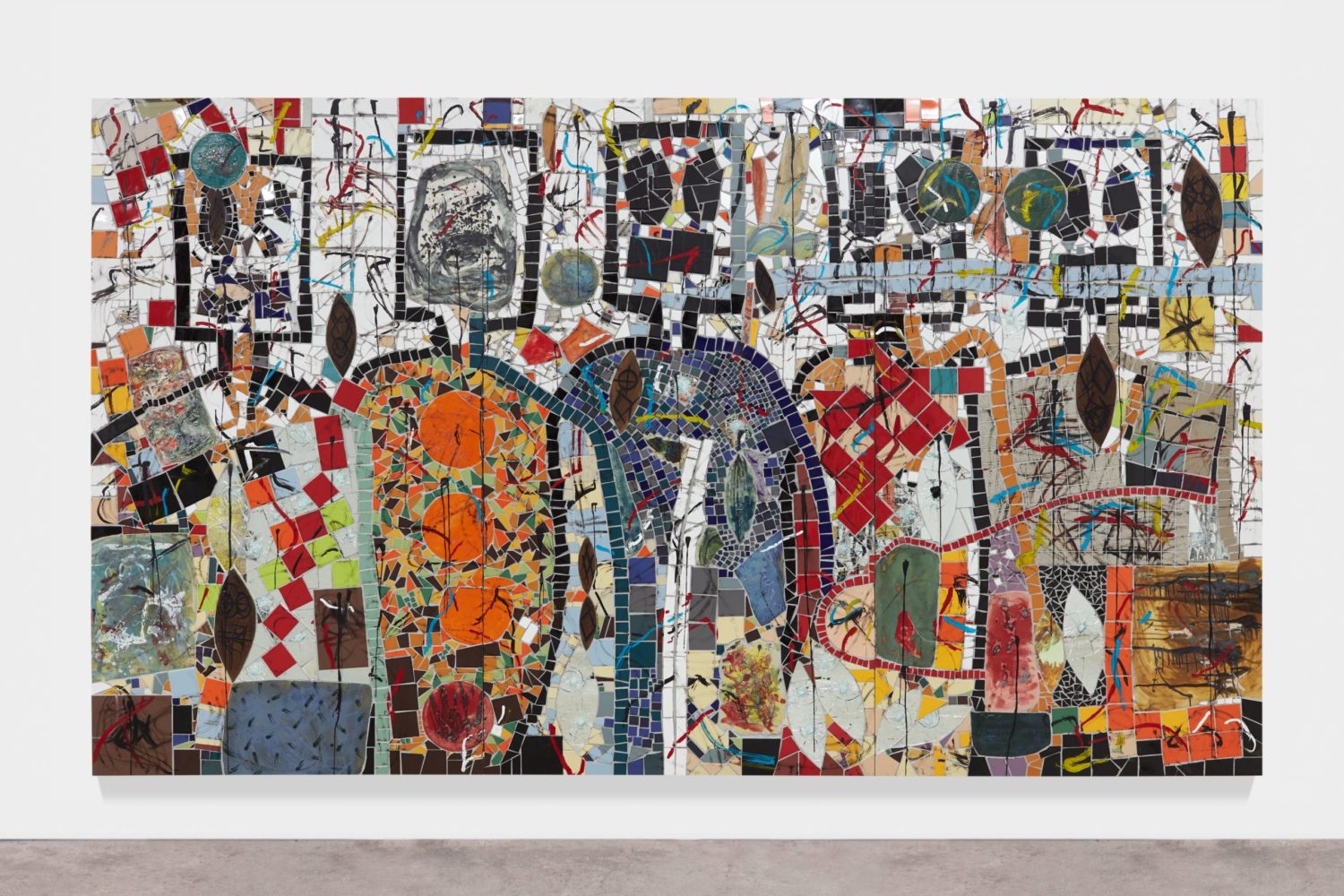
Rashid Johnson, “The Broken Five,” 2020, ceramic tile, mirror tile, spray enamel, oil stick, black soap, wax, 250.2 x 430.5 cm; photo by Martin Parsekian, © Rashid Johnson; courtesy of the artist and Hauser & Wirth.
WW: You’ve created the universal symbol for that.
RJ: It’s like the smiley face, or the peace sign. This is anxiety. It’s really interesting that way. And it’s interesting that maybe we didn’t have a symbol for it previously. It was something that universally understood, anxiety, it’s not a new condition, yet there was still space to frame really specifcally.
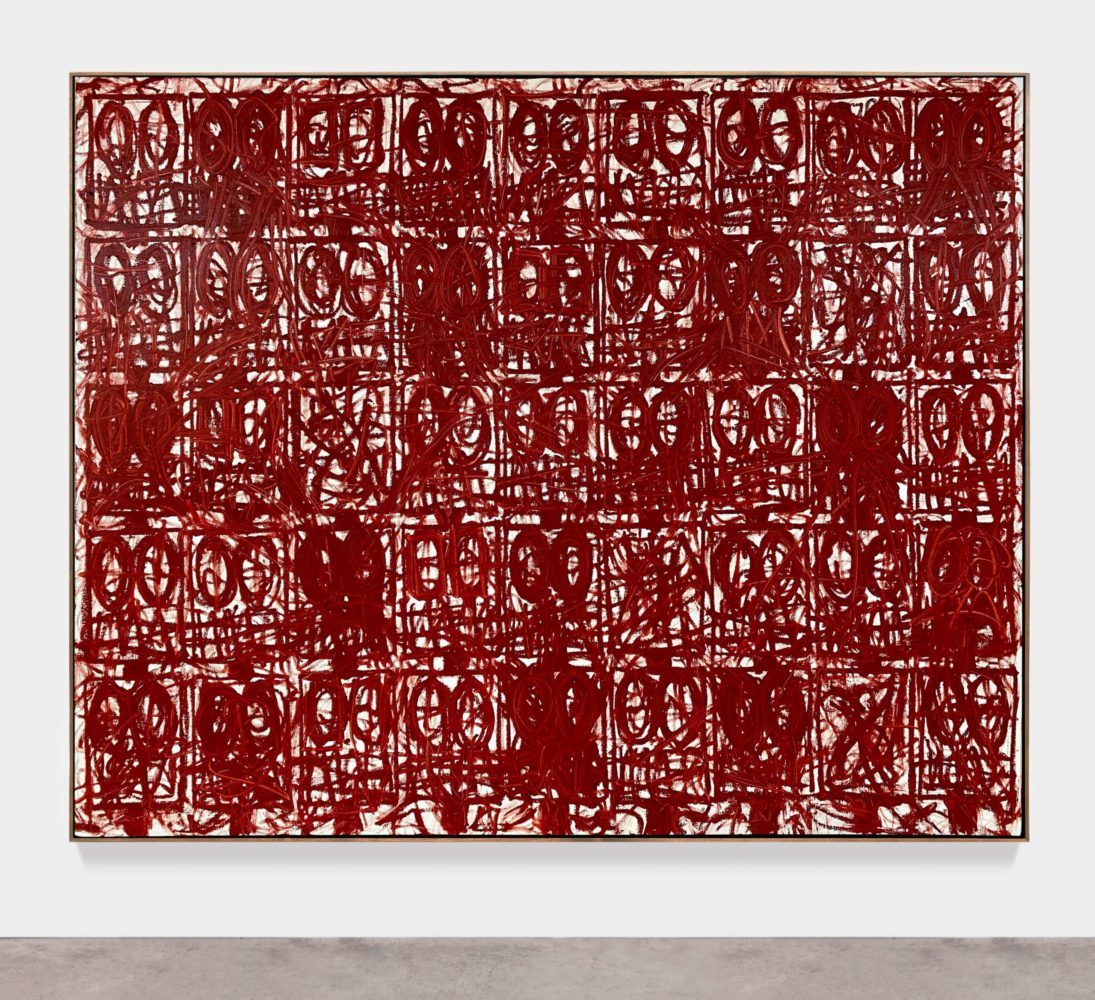
Rashid Johnson, “Anxious Red Painting, August 6th,” 2020, oil on linen, 239.1 x 305.1 x 5.1 cm; photo by Martin Parsekian, © Rashid Johnson, courtesy of the artist and Hauser & Wirth.
WW: And the “Red Anxious Drawings” made this spring in response to the global pandemic also felt universally understood. I saw those and was like, “Yup, I’m feeling that.”
RJ: Boy, you and me both! Yeah, again, small moves, small changes, can produce significant shifts in how we understand symbols and signs. To change something simple as the path and the viscosity, and for that to be able to pivot to consume the time that we’re currently living, is again a really interesting journey for this idea. In that respect, it feels like it has a relationship to history painting. Not dissimilar from—and not to make a comparison in any respect—but to how we would imagine Guernica and its representation of war. If you were to look at Guernica today, it would pivot to consume this time. Or Edvard Munch’s The Scream. I’d never imagined myself to be an artist who had an investment in any sort of populist concern but, I don’t know, maybe it can carry itself into these other more broad conversations about the human condition.
WW: The themes you’ve always returned to in your work—anxiety and escapism—could not be more relevant at this moment.
RJ: I’ve never wanted to be less relevant!
WW: [Laughs]
RJ: I would prefer we be less invested in the things that have driven my practice because of the circumstances, but I’m glad if some of what it is I explore and how I explore it can be effective in translating how we’re all feeling and making us feel less alone as a result.
WW: What has your studio practice looked like for the past few months?
RJ: I’ve been working. I’m on the board of the Guggenheim Museum, and I’ve been working for them to create change, which I think is ideally quite positive. It’s been a very complicated time for institutions. But cultural institutions feel quite motivated to change outside of being affected by their bottom line. The corporations jump to change when they see that it’s going to affect their ability to continue to grow. I think cultural institutions jump to change when they see themselves as potentially being on the wrong side of history. Cultural institutions are under fire, and rightfully so, and ideally going to be stepping up to the plate and responding with real ambitious solutions.
I’m working on a show that opens at Hauser & Wirth that I’ve been working on for over a year. It includes mosaics, some of the “Anxious Red Paintings,” a bunch of bodies of work. It’s been really an incredibly welcoming transition of my project—working very much alone, on these big paintings, and my studio, listening to Percival Everett books and music and learning about some things that were underexplored in my process.
And hanging out with my son and my wife and hoping that some of this enthusiasm and ambition can translate into real tangible change.
WW: This fall, you opened “Stage” at MoMA PS1 in New York. What kind of interactive experience did you want to create?
RJ: It includes five microphones on a stage, and each of those microphones works and amplifies the voice of whoever comes in contact with it. Each mic sits at a different height, so you have to move your body in different directions in order to participate. For me, that’s really an interesting scenario. Some of the mics are to a height to which you would go on your knees and pray to them; others are so low, you’d have to perform on all fours. Others are so high you’d have to perform on your tippy-toes. I guess it speaks to this idea of, “What are you willing to do to amplify your voice? What position are you willing to put your body in to be heard?”
It’s something I’ve explored in my work since I was in undergrad. People haven’t gotten to see this aspect of my project, but it’s one that’s really been present for a long time for me. It’s kind of like an authored and unauthored project. I want people to take advantage of it and do whatever they hell they want with it. It’s not for me to dictate or suggest what and how people should engage with it.
This work is one that says, “Hey, your voice can be present at the museum. Maybe we can’t put up all your paintings right now, but this is an opportunity to be heard in these spaces and that’s a great place to start.”
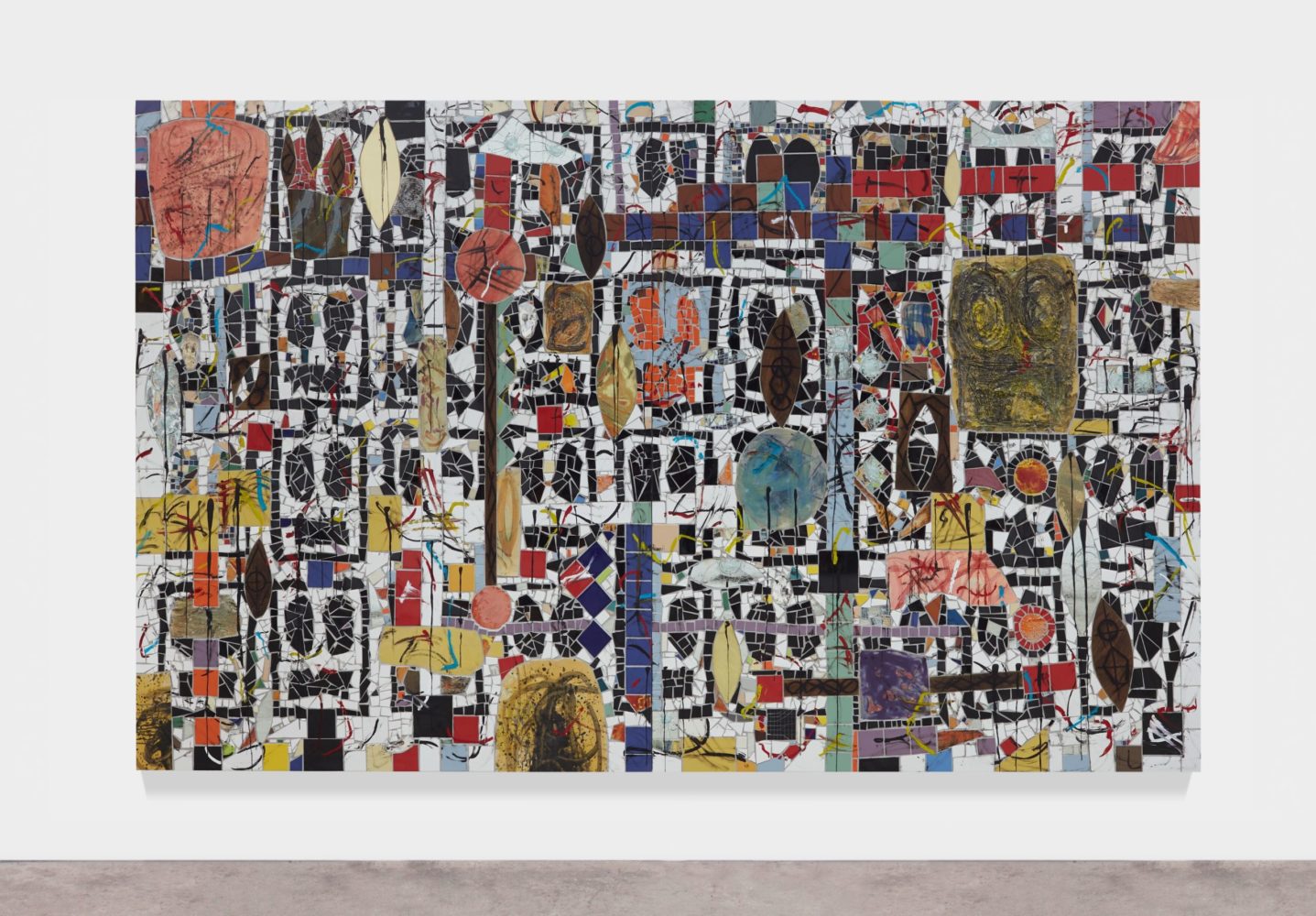
Rashid Johnson, “Broken Crowd,” 2020, ceramic tile, mirror tile, spray enamel, oil stick, black soap, wax, 240.7 x 403.9 x 3 cm; photo by Martin Parsekian, © Rashid Johnson, courtesy of the artist and Hauser & Wirth.


